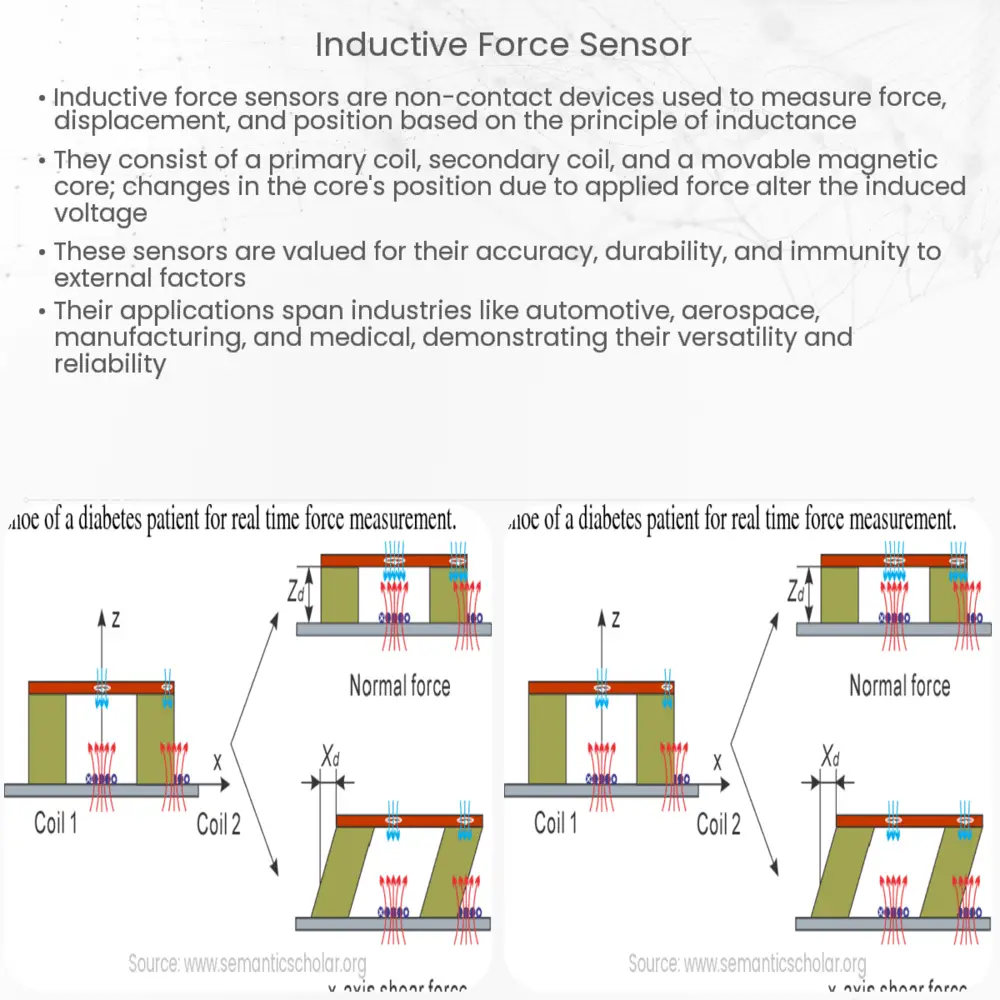Inductive force sensors are non-contact devices that measure force, displacement, and position with high accuracy, used in various industries.

Inductive Force Sensors: Introduction and Applications
Introduction
Inductive force sensors are a type of non-contact sensing technology used to measure force, displacement, and position in a wide range of applications. These sensors work on the principle of inductance, which is the change in an electrical circuit’s inductive reactance as a result of varying current or magnetic field. In this article, we will explore the fundamentals of inductive force sensors, their working principles, and their applications in various industries.
Working Principle
Inductive force sensors consist of a primary coil, a secondary coil, and a magnetic core that moves in response to an applied force. The primary coil is energized with an alternating current, creating a magnetic field that induces a voltage in the secondary coil. The position of the magnetic core, which is influenced by the applied force, affects the coupling between the primary and secondary coils, leading to a change in the induced voltage. By measuring this voltage change, the applied force can be accurately determined.
There are two main types of inductive force sensors: Linear Variable Differential Transformers (LVDT) and Rotary Variable Differential Transformers (RVDT). LVDTs measure linear displacement, while RVDTs measure angular displacement. Both types offer high accuracy, repeatability, and resolution, making them suitable for a variety of applications.
Advantages of Inductive Force Sensors
Inductive force sensors offer several advantages over other types of force sensors, such as strain gauges and capacitive sensors. Some of these advantages include:
- Non-contact measurement: Since the sensing elements do not come into contact with the measured object, inductive force sensors have minimal wear and tear and a longer operational life.
- High accuracy and resolution: Inductive force sensors can provide precise measurements with a high degree of resolution, making them ideal for applications that require accurate and repeatable force measurements.
- Wide operating temperature range: The performance of inductive force sensors is not significantly affected by temperature variations, allowing them to operate reliably in a wide range of environments.
- Immunity to external factors: Inductive force sensors are largely immune to electromagnetic interference, vibration, and contamination, making them suitable for use in harsh industrial environments.
Applications of Inductive Force Sensors
Inductive force sensors are used in a variety of industries and applications due to their versatility, accuracy, and reliability. Some common applications include:
- Automotive: In automotive applications, inductive force sensors are used to measure the displacement of suspension components, brake pedal force, and engine valve position.
- Aerospace: In the aerospace industry, inductive force sensors are utilized for measuring the position of control surfaces, engine thrust, and landing gear forces.
- Manufacturing: In manufacturing settings, inductive force sensors can be used to monitor the force exerted by robotic arms, measure torque in motors and drives, and assess the tension in conveyor belts.
- Medical: Inductive force sensors are used in medical applications to measure the force applied by surgical instruments, as well as the displacement of prosthetic limbs and implants.
Oil and Gas Industry
Inductive force sensors play a crucial role in the oil and gas industry, where they are employed to measure the force and displacement of drilling equipment and components. They can be used to monitor downhole drilling forces, as well as the tension and compression in drilling pipes. In addition, inductive force sensors are used in the control systems of drilling rigs to ensure optimal performance and safety.
Construction and Civil Engineering
In the construction and civil engineering sector, inductive force sensors are used to monitor the structural health of buildings, bridges, and other infrastructure. They can measure the displacement and force experienced by structural elements due to changes in load or environmental conditions, providing valuable data for assessing the integrity and safety of these structures. Furthermore, inductive force sensors are used in the development of smart materials and systems for active vibration control and damping in buildings.
Research and Development
Inductive force sensors are widely used in research and development applications across various fields, including materials science, mechanical engineering, and physics. They can be employed to measure the mechanical properties of materials, such as stress, strain, and elasticity, as well as the performance of mechanical systems, such as actuators and engines. In addition, inductive force sensors are often used in the development and testing of new sensor technologies and applications.
Conclusion
Inductive force sensors have proven to be a versatile and reliable sensing technology with numerous applications across a wide range of industries. Their non-contact measurement capabilities, high accuracy and resolution, and immunity to external factors make them a valuable tool in various settings, from automotive and aerospace to manufacturing and medical applications. As technology continues to advance, it is likely that the applications of inductive force sensors will continue to grow, providing new opportunities for innovation and improvements in safety, efficiency, and performance.
References
- Doebelin, E. O. (2004). Measurement Systems: Application and Design (5th ed.). New York: McGraw-Hill.
- Rao, S. S. (2011). Mechanical Vibrations (5th ed.). Upper Saddle River, NJ: Prentice Hall.
- Baggini, A., & Fantoni, G. (2013). Inductive Sensors for Industrial Applications: A Review. Sensors and Actuators A: Physical, 204, 34-44.
- Kreutzer, J., & Werthschützky, R. (2016). Inductive Displacement Sensors. In G. Finkenzeller & J. Müller (Eds.), Handbook of Measuring System Design (pp. 233-248). Hoboken, NJ: John Wiley & Sons.


